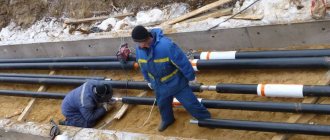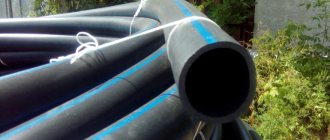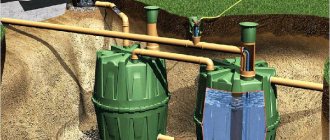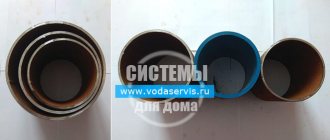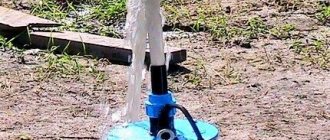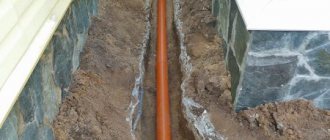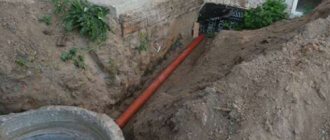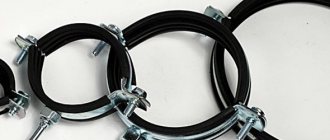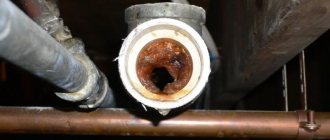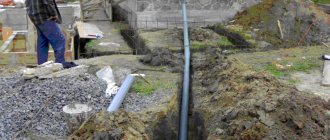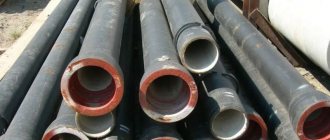- Introduction
- Technical requirements for the sewer pipeline
- Which pipes are best for sewerage?
- What material is best to choose sewer pipes from?
- Size and diameter of sewer pipes for a private house or apartment
- Sewer pipe slope
- Purchasing HDPE pipes at wholesale prices
Requirements for sewer pipes
The common sewer line involves two interconnected systems - internal and external. The choice of pipes for each of them has its own characteristics and requirements. Everything is based on building codes.
External pipeline
Due to the location of the pipes of the external sewer system, they must have the properties of resistance to dynamic and static loads. In other words, they must withstand the deformations that occur when people and vehicles move, and also support the load of the soil laid on top. The connection points must ensure the absence of displacements that could disrupt the integrity of the entire pipeline during the movement of groundwater.
In accordance with SNiP 2.04.03-85, pipes for the external sewage system must be laid below the freezing level of the soil in winter. It will be different for each region of the country. The value for your area must be clarified on the Internet or the meteorological service. In general, for a private house the building level will be 0.5-2 m.
In those areas that are located at intersections with transport routes and increased load, corrugated metal-plastic pipes are laid. They are able to withstand increased loads. This property is due to ring rigidity. In addition, they are characterized by great flexibility. This also makes it possible to lay sewer pipes in particularly complex and non-linear areas.
Internal pipeline
The pipes that are used to create the internal system do not have the above strength requirements. They can be laid in building structures or hidden under decorative elements. Whatever the laying scheme, the internal sewerage system is not subject to the same loads as the external one. But still, to ensure the longest service life, the following properties must be ensured:
- Resistance to mechanical damage;
- Resistance to aggressive environments - temperature, chemical and biological influences;
- Possibility of combination with elements of external sewerage;
- Polished internal surface that does not interfere with the drainage of waste water;
- If necessary, connect all necessary sanitary devices.
Separately, it is worth noting that a significant consumer factor is the ability to easily and simply carry out installation, as well as, if necessary, replace the damaged area. Taking into account all the requirements, the majority of homeowners prefer to use plastic pipes or composite metal-plastic ones.
Next, we will consider possible options for materials for sewer pipes.
How deep should sewer pipes be buried?
SNiP 2.01.01.82 contains data on the depth of soil freezing in various climatic zones. According to SNiP, the pipe exit from the house should be 30 cm above the average freezing depth. The depth of the sewer system should not be less than 70 cm, although in most regions the pipes are buried to a depth of at least 1.5 m. Installation of sewer pipes in a country house is, on average, carried out at a depth of 1.0 m from the soil surface. According to experts, such a foundation is quite sufficient for reliable operation of the sewerage system.
A prerequisite for sewer installation is the correct slopes - only in this case will it not freeze and become clogged.
Asbestos cement pipes
Made from a mixture of cement and asbestos fiber. Among the advantages are the following:
- Long service life (50-100 years);
- Resistance to aggressive influences. Capable of passing any type of liquid;
- Light weight. This property can facilitate installation;
- The inner surface is resistant to clogging. This means that the internal lumen decreases very slowly.
- Easy to install. The installation process can be carried out without the use of any special tools.
But there are also disadvantages. These include significant fragility and instability to mechanical stress. Most often problems occur at the ends of pipes. Therefore, when purchasing, you should pay attention to them.
Choosing a diameter according to building codes
For sewer channels, pipes with an internal diameter of 50-110 mm are used. and wall thickness more than 3 mm. The dimensions are determined by the purpose of a particular channel:
- 50-75 mm. Relevant for organizing drainage from sinks.
- 90 mm. Suitable for an apartment bathroom.
- 100-110 mm. Used to connect a toilet.
To install utility lines for industrial or general purposes in the urban and private sectors, it is necessary to lay pipes with a larger internal diameter (160-200 mm to the collector unit and from 300 mm to the treatment plant with a wall thickness of more than 3.9 mm). These include risers of high-rise buildings, sewer channels that drain wastewater outside a particular building.
Ceramic pipes
Sewage pipes from this material were made in ancient times. Nowadays, ceramics continue to be popular in certain situations. Everything is explained by the significant advantages of the products:
- Resistant to chemicals. Provide the ability to move any type of liquid;
- The inner surface has virtually no roughness. This reduces the risk of blockages;
- Not exposed to temperature;
- Easy installation.
However, among the disadvantages there is also fragility. This imposes certain restrictions on the installation process and transportation. In addition, it is necessary to note the short length of the pipe sections. This helps to increase the number of joints in the highway.
SNiP
Before you buy large-diameter sewer pipes, you need to familiarize yourself with the requirements of SNiP. There are systems designed for use in large cities; accordingly, they have larger diameters and communications that are used in urban-type settlements or villages. Based on the standards specified in sanitary norms and rules:
- For installation of sewerage systems in urban networks with a flow of more than 300 cubic meters in 24, pipes with a diameter of 150 mm are used;
- To install drainage for industrial premises - up to 130 mm, but it is necessary to use a sealing collar;
- Laying pipes for non-pressure sewers is permitted with communications up to 100 mm.
Various domestic and foreign companies are engaged in the production and installation of sewerage pipes. The price of communications directly depends on the diameter and material of the drain. Before installing already selected pipelines, it is advisable to consult with a specialist in order to prevent possible leaks and emergency situations due to a discrepancy between the requirements and the purchased pipes.
Cast iron pipes
Until recently, sewer pipes made of cast iron were a traditional common solution. The most popular size is 160 mm. The material has many advantages:
- Highly durable. Able to withstand significant loads;
- Long service life;
- Resistance to corrosive influences;
- Resistance to aggressive liquids and temperature changes;
- Easy to install.
However, the most significant disadvantage is the weight. This leads to the fact that during installation it is often necessary to use special equipment. In addition, the inner surface has increased roughness. This property contributes to the formation of deposits and blockages. Despite the resistance to aggressive environments, there is one limitation. It cannot be used in conjunction with saline solutions or in saline soil.
How to choose the right diameter?
But now it’s time to figure out the most important thing - how to choose the right diameters for the external and internal networks?
There are 2 methods - non-calculated (according to SNiP) and calculated.
- Non-settlement method:
According to GOST No. 21.604 “Water supply and sewerage”, for laying internal sewerage it is necessary to use the following sizes of plastic pipes:
- bathtub drain pipe - diameter (d) = 40 mm;
- shower - d=40 mm;
- toilet -d=110-150mm mm;
- sink -d=40 mm;
- bidet —d=40 mm;
- sink, washbasin -d=40 mm;
- combined drain for shower, sink and bath—d=50 mm (
- central riser - d= 110 mm;
- bends from the central riser d=60 mm.
In addition to the pipe diameter, it is necessary to select the correct slope.
- Calculation method:
SNiP 2.04.01-85 describes methods for calculating diameters for sewerage in an apartment and a private house. They are complex, taking into account the slope of the pipeline on horizontal sections of the main line, the angle of connection of the leads and other nuances.
To calculate the outer diameter of a sewer pipe, there is a special formula:
D = V ( √ h / d) ≥ K, where:
- D—pipe outer diameter
- V is the speed of movement of wastewater (must be at least 0.7 m/s);
- K is a coefficient depending on the type of material (selected according to SNiP);
- h/d - pipeline filling indicator - the ratio of the flow height h (maximum) to the internal diameter less than 0.6. If clean wastewater moves through the pipeline, this value can reach 0.8
Advice: You should not do the calculations yourself, the probability of error is too high. Use the services of a professional.
Smallest permissible pipe diameters:
- For external networks inside the block −150mm;
- For external street network - 200mm;
- For an external stormwater drainage network −220mm;
- For pressure networks - 150mm.
When constructing a private residential building, the internal diameters are taken from SNiPs or calculated based on all the parameters listed above. For an external network, in any case, a pipe of 150mm-200mm will be sufficient.
Correspondence between the diameter of the pipe and the plumbing fixture (toilet, sink, etc.)
The size of the sewer pipe does not always correspond to the size of the pipes of the plumbing fixtures. For example, the sink corrugation usually has a diameter of 30mm, and the waste pipe has a diameter of 50mm. What to do?
The answer is simple - you need to use connecting fittings.
Connecting elements
The range of fittings is very wide. They are made of cast iron, PVC, polyethylene, polypropylene, as well as the pipes themselves.
When installing pressure systems, tees, bends, pipes, sockets (double and single), O-rings, and saddles are used.
Plastic types of fittings are distinguished by their light weight, long service life, resistance to temperature fluctuations and a wide range of types.
Let's look at some types of shaped products:
- Tee - used to connect 2 or more pipes at an angle of 45, 60, 90 degrees;
- Coupling - connects two parallel sections of the pipeline;
- Retraction - allows you to rotate 90 degrees when laying;
- Reduction - connects two different diameters and materials;
- Cross - performs perpendicular branches;
- Branch pipe - used when replacing a damaged or cut section of a pipeline;
- Plug - blocks the movement of fluid during repairs.
PVC pipes
Polyvinyl chloride is one of the most affordable materials. Sewage pipelines made of this material have the following advantages:
- Polished walls. No deposits are formed;
- High strength;
- Low temperature resistance. It will not crack even if it freezes completely;
- Light weight;
- Ease of installation;
- Resistance to corrosive influences;
- Low price;
- High level of wear resistance.
The main disadvantage is the thermal elongation of the product. That is why they are not used in pipelines in which liquids with temperatures exceeding 60⁰С are transported.
The parameters of such products may vary depending on the type of production. So, now you can find single-layer and three-layer PVC pipes. Products can be divided by hardness:
- Class "S". Tough. Used for laying at depths of up to 8 meters. Maximum wall thickness.
- Class "N". Medium hard. For a depth of 2-6 meters.
- Class "L". Lungs. Depth 0.8-2 meters.
Size tables and pipe specifications
After choosing the material, special attention is needed to the size of communications.
We summarize the diameters for internal and external gaskets in a general table:
| Network type | Outer diameter, mm | Inner diameter with minimum wall thickness, mm | Minimum wall thickness, mm | Inner diameter at maximum wall thickness, mm | Maximum wall thickness, mm |
| Internal | 32 | 30 | 1,0 | 28,40 | 1,80 |
| 40 | 38 | 1,0 | 36,40 | 1,80 | |
| 50 | 47,4 | 1,30 | 46,40 | 1,80 | |
| 75 | 71,2 | 1,90 | 70,40 | 2,30 | |
| 90 | 85,6 | 2,20 | 84,40 | 2,80 | |
| 110 | 104,6 | 2,70 | 103,20 | 3,40 | |
| Outdoor | 125 | 118,6 | 3,20 | 117,20 | 3,90 |
| 160 | 153,6 | 3,20 | 150,20 | 4,90 | |
| 200 | 192,2 | 3,90 | 187,60 | 6,20 | |
| 250 | 240,2 | 4,90 | 234,60 | 7,70 | |
| 315 | 302,6 | 6,20 | 295,60 | 9,70 | |
| 400 | 384,6 | 7,70 | 375,40 | 12,30 | |
| 500 | 480,4 | 9,80 | 469,40 | 15,30 | |
| 630 | 605,4 | 12,30 | 591,40 | 19,30 | |
| 800 | 769,2 | 15,40 | 751,0 | 24,50 | |
| 1000 | 960,8 | 19,60 | 938,80 | 30,60 | |
| 1200 | 1151 | 24,50 | 1126,80 | 36,60 |
For external sewer networks, the optimal diameter is from 160 to 500 mm, for internal ones - from 32 to 110 mm.
GOST standards:
- GOST 22689.2-89 - polyethylene pipes and fittings;
- GOST 18599, GOST 32413, 51613 - PVC pipes;
- GOST 6942-98 - cast iron products;
- GOST 32414-2013 - polypropylene.
Polypropylene pipes
Such products are ideal for creating external or storm drainage systems. Among the advantages are the following:
- Resistance to temperature and corrosion;
- Inertness to chemicals;
- Polished inner surface. It is possible to get clogged due to incorrect installation;
- High service life;
- Light weight;
- Easy to install.
The range of polypropylene pipelines is huge. It is possible to find elements for a system of any complexity.
Choosing the right type of sewage system
The process of arranging a sewerage system
The choice of a sewerage system must be made at the stage of building a house; first of all, you should find out whether it is possible to connect to a centralized sewerage system.
If this is not possible, then you will have to start installing a local sewer system.
Owners of houses connected to a centralized sewer system do not need to independently maintain the sewer systems, but they should pay their bills for sewer use up-to-date, otherwise they may face such a problem as turning off the sewer system for non-payers.
When creating an autonomous sewer system, everything is much more complicated.
The first step is to decide on the type of sewer system, wisely weighing all the pros and cons of various systems.
For example, when choosing the type of autonomous sewage system, many people prefer a cheaper and easier-to-equip cesspool, rejecting the option of installing a modern system with wastewater treatment as expensive and difficult to install, without taking into account that the service life of the cesspool is noticeably shorter.
The construction of a system with treatment facilities requires at the initial stage certain costs for the hydraulic calculation of the sewer network, materials for installing the system, and wages for specialists installing the sewer system, but much less trouble arises during the operation phase.
The undoubted advantages of modern sewer systems over the same cesspools also include the absence of an unpleasant odor and a negative impact on the environmental installation,
In addition, simpler sewer systems require more financial investment in maintenance and repair.
Just to remove waste from the cesspool, you will have to call sewer trucks at least twice a month, whereas a conventional septic tank only requires annual cleaning of the chambers, and installations that carry out complete biological treatment of wastewater require even lower maintenance costs, since only replacement of the filter membrane is required once every 2-3 years.
All this allows modern sewer systems to recoup installation costs during the operation phase due to low maintenance costs.
Before you start building a country house, country house or cottage, you should study in detail the various types of sewage systems in order to have an idea of their advantages and disadvantages, and then choose the most suitable option, taking into account all sorts of factors, from the area in which construction is taking place to the amount , which can be spent on sewerage installations.
Previous entry What types of sewer manholes are there and why sewer manholes are made round Next entry Calculation and installation of external sewerage. Domestic and storm sewerage.
Polyethylene pipes
They are another type of plastic pipe. Also popular when installing external sewerage. Advantages:
- Durable;
- Temperature resistant;
- Easy installation;
- Polished inner surface.
However, among the disadvantages of polypropylene products is high sensitivity to ultraviolet radiation. In this regard, the material can only be used excluding exposure to the sun.
Rating of vent pipe manufacturers
| Photo | Name | Rating | Price | |
| #1 | Rehau | ⭐ 4.95 / 5 2 - votes | Find out the price | |
| #2 | Ostendorf | ⭐ 4.9 / 5 4 - votes | Find out the price | |
| #3 | Hemkor | ⭐ 4.85 / 5 | Find out the price | |
| #4 | Politek | ⭐ 4.8 / 5 2 - votes | Find out the price | |
| #5 | Sinicon | ⭐ 4.75 / 5 | Find out the price | |
| #6 | Wavin | ⭐ 4.7 / 5 | Find out the price |
What would you choose or recommend?
Take the survey
In this list, we propose to get acquainted with the best manufacturers of sewer pipes that can be found on the Russian market. They all produce reliable products, and it’s up to you to decide which one to choose.
No. 1 – Rehau
Rehau sewerage pipes
The Rehau brand is known to everyone who has faced such tasks as repair and construction. He has a huge range of all kinds of products, including fan pipes for both non-residential premises and residential buildings. The pipes are made of polymer, have three reliable layers and are also reinforced in the area of bends and turns. They are reliable and durable, and perfectly absorb noise. The first inner layer is protected from corrosion, the second has additional mineral reinforcement, and the third is designed to easily withstand vibration and shock. The very first layer, by the way, is quite smooth, and no deposits form on it. The products can be installed in almost any conditions, even laid outside. In general, pipes from this brand are very resistant to thermal and chemical influences, they are practical and can be used not only in ordinary cases, but also where networks have a special purpose. And we must pay tribute - their prices are quite reasonable.
pros
- service life up to 50 years
- suitable for use in networks for various purposes
- three-layer polymer
- excellent sound absorption
- ease of installation
- resistance to thermal and chemical influences
- moderate cost
Minuses
- not detected
Prices for sewerage pipes Rehau
sewer pipes Rehau
Reviews of Rehau sewer pipes
No. 2 - Ostendorf
Ostendorf sewer pipes
This is a German manufacturer, widely known throughout the world, including in Russia. It produces pipes made of polypropylene, but not ordinary, but mineralized, which is of high quality. The material absorbs sound well, which means the buyer will hear almost no water noise. Pipes from this manufacturer are designed for installation of an internal drainage system, but can be easily combined with a wide variety of sewage systems. One of the main advantages is the presence of a convenient scale directly on the product, which will allow you to measure the desired length without difficulty, which speeds up and facilitates installation. And the pipes themselves are quite light, which also gives +100 to the ease of performing the work. The manufacturer reports that its products can last up to 100 years without complaints. They are not afraid even of high temperatures, do not rust, and are not afraid of aggressive chemical influences. In addition, they are environmentally friendly and safe and are even suitable for recycling. Perhaps these fan pipes are considered the most popular in Russia, despite the rather high cost.
pros
- very durable
- muffle sounds
- durable
- resistant to various types of impact
- ease of installation
- environmental friendliness
Minuses
- high price
Prices for sewerage pipes Ostendorf
sewerage pipes Ostendorf
No. 3 - Hemkor
Sewage pipes Hemkor
Manufacturer from Russia, producing inexpensive and reliable PVC pipes. Moreover, during production a special technology is used that allows the formation of an internal foam layer. Thanks to this, the pipes are 33% lighter than their analogues. Products from the range are suitable both for arranging sewerage systems inside and outside the house. There are also options that are used for wells and pressure water supply systems. Hemcor products can withstand high pressure and are suitable for use in difficult conditions - at elevated temperatures for a long time. They are inexpensive, resistant to exposure to various chemicals, hygienic and easy to install (due to their low weight). They are very hygienic and do not contribute to the formation of dirt deposits on the walls.
pros
- withstand high pressure
- low price
- heat resistant
- hygienic
- lungs
- large assortment from the manufacturer
Minuses
- not detected
Prices for sewer pipes Hemkor
Hemkor sewer pipes
No. 4 - Politek
Sewage pipes Politek
A manufacturing company from Russia, well known in the market for its polypropylene pipes and fan products made strictly in accordance with GOST. The products are used for arranging drainage in internal or external systems, suitable for residential buildings, administrative and even industrial buildings. The material from which these lightweight pipes are made offers excellent resistance to both fecal and waste water. Pipes from this company are reliable, smooth on the inside and do not contribute to the appearance of dirt accumulations, do not heat up, are easy to install and can withstand high temperatures of up to 100 degrees, although only for a short time. The declared service life is about 50 years. It is only important to remember that using these products at temperatures below -10 degrees is prohibited - the material quickly loses its properties and the pipes may be damaged. But at temperatures down to -10 they can be used - after more favorable conditions return, the pipe material quickly restores its shape.
pros
- reliability of connections
- don't get clogged
- easy to install
- withstands heating up to +100 degrees, although not for long
- resistant to chemicals
- durable
- stronger than metal-plastic
Minuses
- cannot withstand very low temperatures
Prices for sewerage pipes Politek
sewer pipes Politek
Reviews of sewerage pipes Politek
No. 5 – Sinikon
Sinicon sewerage pipes
are a Russian-Italian brand whose products skillfully combine moderate cost and European quality. It produces polypropylene fan pipes and various components for them. The brand's products are very popular in Russia, because they are characterized by a long service life - up to 50 years. The pipes can withstand strong heat very well - wastewater with temperatures up to +95 degrees will definitely not harm the material and will not cause leaks. The products are not afraid of chemical components, even quite aggressive ones - they do not crack or collapse even after a long time, and can be used at a pH level in the range of 2-12. The inside of the pipes is very smooth, and dirt does not settle on them. And yes, they absorb noise well, making them ideal for use in apartment buildings. But, alas, these pipes are prohibited from being used to drain industrial wastewater without first checking for stability.
pros
- absorb noise
- are not afraid of chemical exposure
- very heat resistant
- European quality level
- relatively long service life
- environmentally friendly
Minuses
- pipes cannot be used for industrial wastewater
Prices for sewer pipes Sinicon
Sinicon sewer pipes
No. 6 – Wavin
Wavin sewerage pipes
are a Dutch brand that entered the market in the mid-50s of the last century. Its founder once wondered how to get rid of rusting pipes. And he set himself the task of solving this problem by developing a new communications system. Since then, the brand has been producing reliable plastic pipes for drinking water and plastic pipes for drains, which have become very popular. The brand's enterprises are now located throughout Europe. The pipes that the company produces are used for the construction of internal sewerage systems; they are made from PP and PVC. Easy to install due to simple connections and ideal geometry, withstanding high heating temperatures, with a long service life of up to 50 years, these products are in demand all over the world, including in Russia. The main disadvantage is that these pipes are not always easy to find for sale in regular stores.
pros
- low roughness coefficient
- the company has been on the market for many years
- durability of use
- heat resistance
- perfect geometry
- ease of installation
Minuses
- hard to find on sale
Prices for sewerage pipes Wavin
Wavin sewerage pipes
Which material should you choose?
Since in the article we are considering the question of which pipes are better than a private house, we will summarize what to choose.
- Concrete and reinforced concrete - used in industrial construction. Local sewer networks are constructed from them. They differ in significant weight and dimensions.
- Cast iron is high-strength, temperature-resistant, but heavy. Now they are not used often. Even in multi-apartment construction, the volume of their use is decreasing. Even despite the long service life.
- Steel, ceramic and copper are too expensive and not very reliable for use in sewers. The installation and replacement process is complex.
- Asbestos-cement - resistant to biological and chemical influences. Quite suitable for sewer networks. However, fragility reduces their performance even before installation.
- Polymers are a relatively new type of product. There are models with different consumer characteristics. The class includes various plastic pipes for sewer networks. They are distinguished by significant strength, long service life, ease of installation and compatibility with other equipment.
- PVC pipes are the best choice for gravity sewerage. Suitable for installation of external and internal systems. Resistant to mechanical damage and ultraviolet radiation. Temperature does not affect performance. They do not tolerate exposure to household chemicals very well.
- Polypropylene - not exposed to aggressive chemicals. Resistant to mechanical damage. Capable of passing high temperature liquids.
The sewer pipe market is much broader than described in the article. Here are the characteristics of the most common materials. It is impossible to say for sure that one of the options is better than the others. For each pipeline, specific operating conditions must be taken into account. It is by taking into account all the nuances of the site that you can choose the best option.
We recommend reading:
- How to connect plastic sewer pipes;
- How to independently determine the diameter of the pipe;
- Methods for connecting a metal pipe to a plastic one
Purchasing HDPE pipes at wholesale prices
Every owner of a private home who has begun renovations faces the question of which pipes to buy for sewerage. This is also a pressing problem for owners of apartments and businesses, since it is important to initially build a sewer system so that problems do not arise after a few years.
The practice of many experts shows that polyethylene pipes are considered the best option. They attract with their affordable cost, reliability and ease of installation. Therefore, when choosing which pipes to use for pipe sewerage, many choose this option and subsequently do not regret their decision.
, which is the largest pipe manufacturer in the Far East, offers for purchase polyethylene pipes of various diameters that can be used for sewage. Thanks to our own production, we can offer favorable wholesale prices to all our clients. We guarantee high quality products and full compliance with GOST. To find out more about the products, leave a request on the website or call us - 8. We will answer any questions and help you choose the right option!
Aeration plant in a suburban area
The sewerage system in a private house with an aeration plant (the term VOC is also used, local treatment plant) is considered the most modern for wastewater disposal, the quality of treatment reaches 90%.
These installations in the sewerage system are complex and cannot be done with your own hands. They are based on devices made of fiberglass or propylene, but due to their design with stiffening ribs and many protruding elements, they are not deformed and are not squeezed out to the surface by heaving soils.
ACs operate on a different principle than septic tanks. If in septic tanks wastewater is first mechanically purified during settling, and organic matter is partially decomposed during anaerobic processes, then in AC the main purification occurs during the oxidation of organic molecules with oxygen. In such a sewerage system in a private house, bacteria work, which require oxygen to live (in sewerage systems with septic tanks, this process takes place in filtration wells, filtration fields, etc.).
There are two types of AC – with a compressor or a drain pump. In an AC with a compressor, wastewater, after settling in the first chamber, enters the second, and there it is saturated with oxygen. What happens is that the microflora in the wastewater multiplies wildly and forms activated sludge, which destroys all organic compounds. The water becomes clearer, but now it contains silt particles. All this goes into the third chamber, the sludge settles and is sent back to the aerochamber, and the purified water is removed outside the installation.
In an AC with a drainage pump there are also several chambers, and wastewater moves between them by gravity. The treated wastewater is pumped to the sprayer, then passes through the biofilter, cleaned and discharged outside.
For stable operation of aeration units, electricity is required, and even a shutdown for several hours is fraught with the death of aerobic bacteria. The second disadvantage of AU is its blatant lack of budget; any septic tank always costs less.
The AC on the site should be located below the well or borehole, but so that in the spring it will not be flooded with melt water. Like septic tanks, VOCs are installed in a pit with a sand lining at the bottom.
Many manufacturers allow water to be discharged from the AC directly onto the terrain, into a ravine, forest, or storm drain. This is still a controversial issue, and many are inclined to believe that this should not be done, or only after additional and expensive disinfection; but it is recommended to install AU in areas with clayey and heaving soil, high groundwater level and where there is no possibility of making a filtration well, filtration field and other filtration installations.
Technical means, materials
To create any sewer system you will need building materials and tools. Below are the most necessary ones.
Brief list of materials:
- sewer pipes. Types of pipes are discussed in more detail in the next paragraph.
- connecting elements (adapters, corrugated pipes, corners). Using these means, toilets, sinks, and other plumbing fixtures are connected to the drain or water supply system
- sealing agent. Silicone-based sealants can be used
- mixture for cement. Particularly useful when arranging external sewerage
- sand
- shovels. Shovels will be useful for the entire period of work, from initial marking to digging a pit for a well.
- buckets
- sharp knife
- keys, screwdrivers
- pipe cutter (hacksaw with fine teeth)
- clamps for fastening. When installing internal sewerage, clamps are indispensable
- roulette
- level
Three-section septic tank
Electrical tools that may come in handy:
- Bulgarian. Used for cutting metal. If metal pipes will be used during construction, the desired size can be achieved by cutting them
- hammer drill Communications inside the house will pass through the walls and flooring. Holes in them can be made using a hammer drill
- screwdriver Pipes will need to be fixed to the walls
The set of tools and necessary materials greatly depends on the scope of work and the type of sewer chosen. But the above, as a rule, always apply.
You have determined the type of waste disposal system, stocked up on the necessary tools, and you can move on to construction. Let's start with intra-house communications.
Projects of country houses for 6-10 acres: 120 photos, description and requirements | The most interesting ideas
Why do you need a slope angle?
In order for wastewater in the sewer to take dense particles with it, pipes must be laid at a certain slope. The angle of inclination must be set according to fixed, established SNiP standards. To reduce installation time or with the work of unqualified craftsmen, many end up with a sewer system that operates with irregularities or does not cope with the task at all:
- not paying attention to the fixed norm for setting the slope or when maintaining the slope angle at a value below the minimum, the operation of the entire system is disrupted. With such errors, water flow will be at a reduced speed. This will quickly clog the drain. The drain will need to be cleaned frequently. For example, when installing a toilet, measures to set the pipe slope in the correct position were ignored, then the remains of human activity will not be washed away thoroughly. They will begin to accumulate and decompose. This will lead to the rapid spread of an unpleasant odor throughout the living space;
- if the slope is significantly exceeded, then blockage cannot be avoided. Wastewater passes through communications at high speed, washing solid elements without taking it with it. This will lead to the accumulation of a fetid odor and spread throughout the house;
- If the established angle of inclination of the pipes is not observed, siltation of the main system will occur. The entire sewer system will stop working. An unpleasant odor will arise, and there will be a reason for replacement and cleaning;
- in an apartment building, in the absence of standards for setting the slope, a leakage or breakdown of communications may occur. All residents will have problems with drainage until the problem is resolved;
- plastic pipes installed in the wrong position will suffer from silting and blockages. Cast iron communications are susceptible to corrosion, which leads to leakage - all waste will penetrate into the basement, spreading a stench throughout the entire entrance.
Video on the topic:
Sewage slopes and their setting methods:
and video
How to choose the correct sewer slope:
Also, if there are no problems with corrosion during unsloped installation of plastic, then holes may appear in the cast iron pipe. It will begin to leak water and sewage into the basement.
Previously, in multi-storey buildings, sewers were not installed with a slope, which is why there were so many cases of flooding in an apartment on the first floor or a breakthrough of the entire sewer system.
